Biohabitats Projects, Places, and People
By Amy Nelson
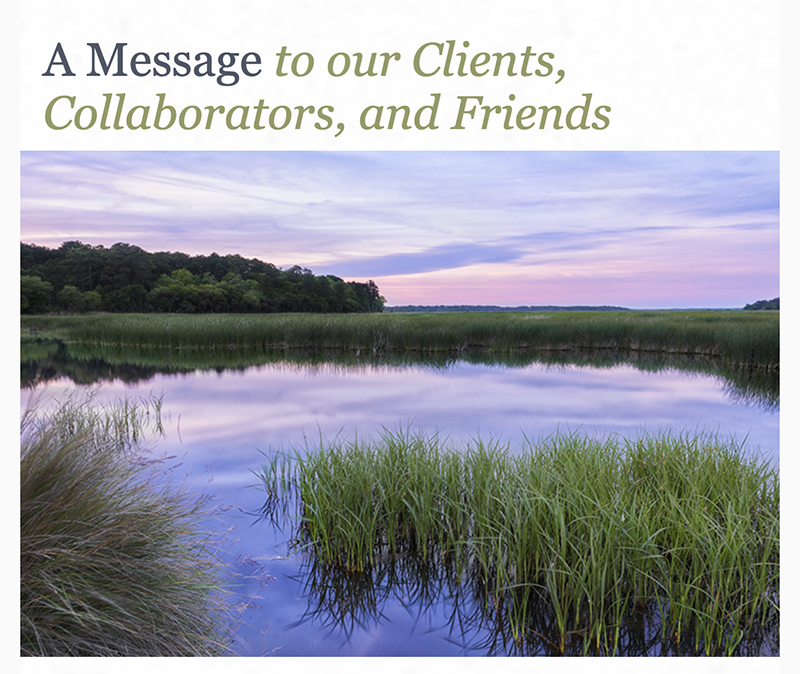
Dear Friends,
I hope this finds you and your families healthy and managing safely in these rapidly changing times. Given the uncertainty of the COVID-19 impact, I want to take a moment to assure that we are actively monitoring all advisories and planning to continue providing the exceptional service you have come to expect from us using the following measures:
Our service and commitment to your projects will continue, and your project manager or other point of contact within Biohabitats will keep you abreast of any changes in how we work together.
Meetings will be scheduled primarily through GoToMeeting or Microsoft Teams, along with other collaboration platforms as needed.
Biohabitats is taking steps to ensure that our technology infrastructure will fully support remote work and collaboration.
Please check our website or social media platforms for the latest updates and additional details about our internal COVID19 response measures.
The health and safety of our team and our communities is our top priority. Biohabitats is committed to protecting the well-being of all those with whom we come into contact — our clients, collaborators, team members, families, vendors, and communities.
Please know that I am always available to discuss your projects or any questions you may have during this challenging time. Thank you for your continued support, and stay safe.
Keith Bowers
President, Biohabitats
Projects
Forest Stewardship: Keeping a Good Thing Going
In 2010, the Anne Arundel County, Maryland Department of Parks and Recreation acquired a 900-acre property in the headwaters of the South River, a tributary to the Chesapeake Bay. Now a popular spot for hiking and mountain biking, the Bacon Ridge Natural Area features coastal plain wetlands, mature forests, and its namesake creek, Bacon Ridge Branch. In addition to its ecological and recreational value, the site holds cultural and historic significance. Once home to a hospital opened in 1911 to serve African American psychiatric patients, the grounds of the natural area contain a cemetery with over 1,800 graves, marked only by numbers. The property also contains several archaeological sites with intact evidence of prehistoric or Native American campsites, structural foundations, and artifacts from earlier centuries.
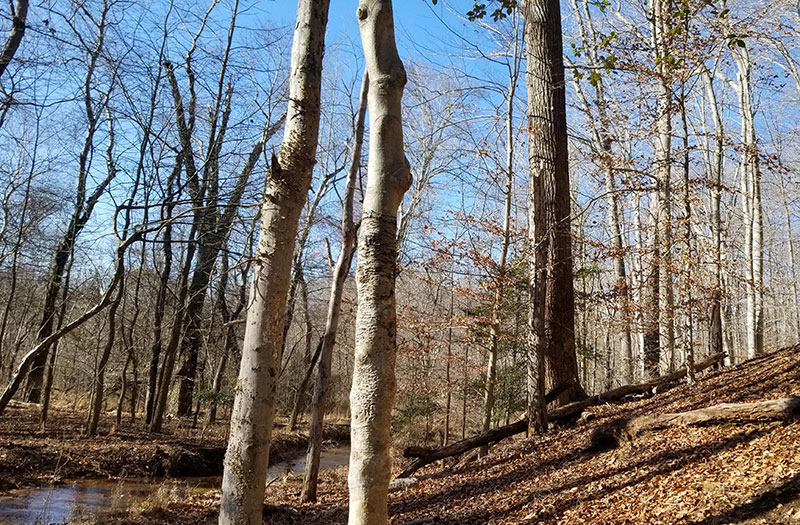
Approximately 630 acres of the site are permanently protected through a conservation easement between Anne Arundel County, the Maryland Environmental Trust, and the Scenic Rivers Land Trust. To help the County meet the terms of the easement and ensure the site’s long-term ecological health while protecting its heritage and recreational resources, we are crafting a Forest Stewardship Plan. After assessing the site earlier this winter, we worked with the County to develop an prioritize strategies for conserving forest areas, removing invasive species, protecting and improving wetlands and waterways, creating and enhancing habitat, removing trash, and creating more forest in non-forested areas. Currently in its final stages, the Stewardship Plan will chart the course for the long-term protection of this important site’s woodland, water, soil, natural heritage, and recreational use.
Transformative Restoration: That’s My kind of Mentor!
After acquiring one of the last remaining pieces of undeveloped land within its bounds, the City of Mentor, Ohio began transforming it into a passive, recreational park, complete with walking paths, picnic areas, and a fishing pond encircled by a boardwalk. Thanks to grant funding from Ohio EPA, that transformation includes the restoration of a channelized ditch on the property. The ditch, known as Wayside Gardens, is a tributary to Marsh Creek, which flows directly into Ohio’s first State Nature Preserve, Mentor Marsh.
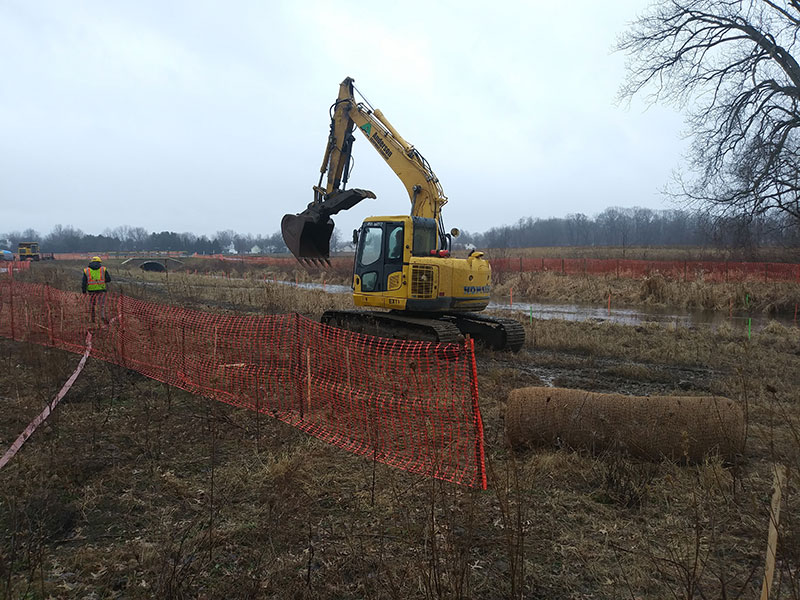
Over past decades, as the watershed developed and stormwater runoff increased, the tributary became disconnected from its floodplain and suffered diminished water quality. We’ve been working with the City of Mentor and its project partners, the Chagrin River Watershed Partners and the Lake County Soil and Water Conservation District, to design the restoration, and we’re pleased to announce that construction has begun! The design takes advantage of the site’s sandy soil by combining riffle complexes and sand seepage berms to retain smaller storm events on the floodplain, promote denitrification, and safely convey larger storm events through the site. Augmented with a native plant palette and the treatment of invasive species, the former ditch will become a biologically diverse, ecologically functioning stream and wetland complex, as well as an engaging park amenity.
Protecting the Future for Oregon White Oak Woodlands
Oregon white oak (Quercus garryana) woodlands are among the most iconic and culturally important habitats of the Portland-Vancouver region. They are home to hundreds of native plant and animal species, including species of conservation concern such as the acorn woodpecker (Melanerpes formicivorus) and the western gray squirrel (Sciurus griseus). Sadly, regional land use changes and shifts in vegetation associated with fire suppression have caused these important ecosystems to become imperiled. Fortunately, the Intertwine Alliance Oak Prairie Working Group (OPWG) is doing something about it. For the past eight years, this coalition of municipal, tribal, nonprofit, and community partners has worked to map Oregon white oak and advance the restoration and stewardship of native oak habitats. To inform their efforts and build upon a Strategic Action Plan they completed in 2018, the OPWG turned to Biohabitats. We are currently helping the group spatially prioritize oak conservation opportunities across the 2,900 square mile planning area.
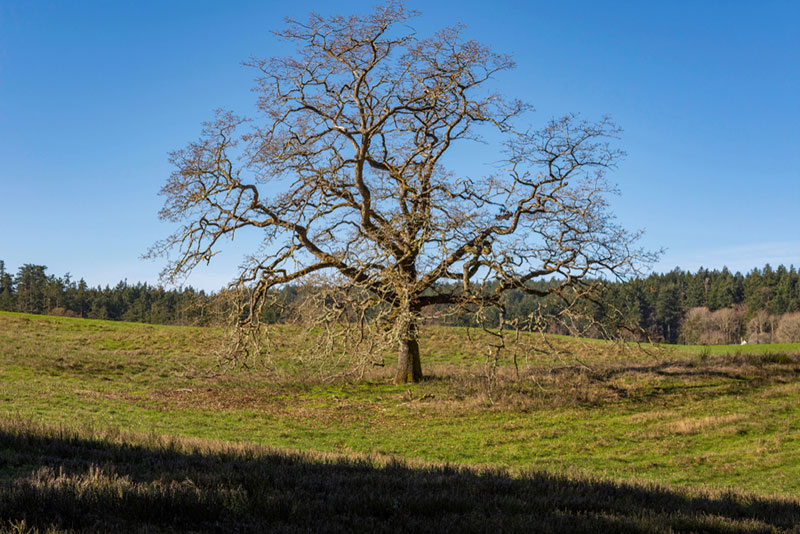
We’re pleased to report that we recently completed a spatial analysis to assign a relative conservation importance value to over 375,000 Oregon white oak observations. Next steps include a regional habitat connectivity analysis and projected land use change analysis to further inform Oregon white oak conservation and restoration priorities. Once those steps are completed, the OPWG will have a powerful, new tool that will further guide the conservation, restoration, and connection of these high value ecosystems.
Freshwater Tidal Wetlands Preparing To Land in Philadelphia
Located near the confluence of the Schuylkill and Delaware Rivers, just northeast of the airport, is the 350-acre urban oasis known as FDR Park. Designed in the early 1900s by John Charles Olmsted and Frederick Law Olmsted, Jr., sons of legendary landscape architect, Frederick Law Olmsted, the popular park features a golf course, rugby field, skatepark, historical museum, and several tennis courts and ball fields. Soon, it will also include a tidal freshwater wetland.
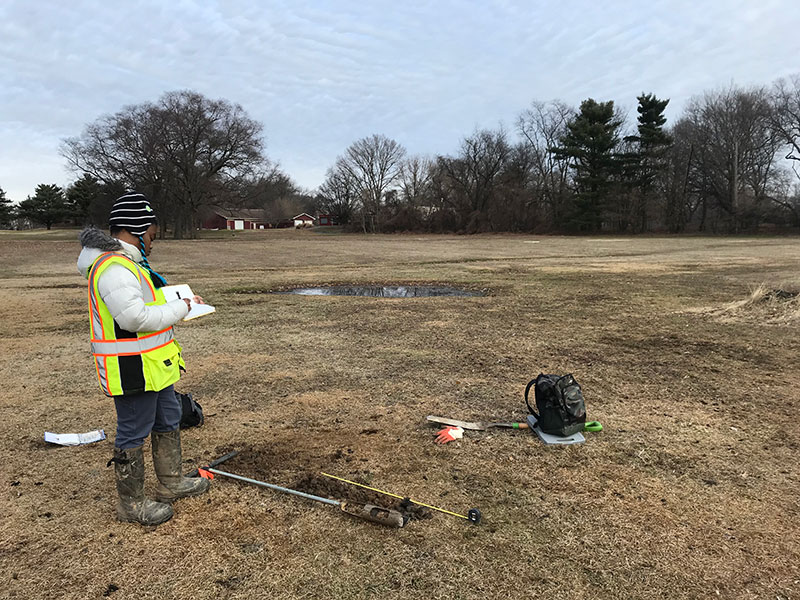
Thanks to a partnership between the Philadelphia Department of Parks and Recreation, the Philadelphia International Airport, and PIDC Philadelphia’s public-private economic development corporation, a neglected, 45-acre portion of the park is being transformed into an ecologically functioning tidal wetland complex, a rarity in such an ultra-urban environment. We’re delighted to be working with the project partners to bring their vision to life, and we look forward to keeping you posted on our progress.
Campus Innovation Extends to Stormwater
The University of Maryland, Baltimore County (UMBC) is a dynamic and rapidly growing public research university located along the densely developed Baltimore-Washington corridor. Ranked by U.S. News and World Report as one of the top 10 most innovative universities, UMBC applies foresight not only to its academic programs, but also to the planning and operation of its facilities. In 2017, with help from Biohabitats, the University developed a Campus Stormwater Institutional Management Plan. Among the plan’s recommended strategies was the idea to combine a necessary utility improvement with the restoration of a severely degraded stream that flowed through the campus. Storm flows from surrounding development had caused bank erosion, downcutting, floodplain disconnection, and outfall headcutting.
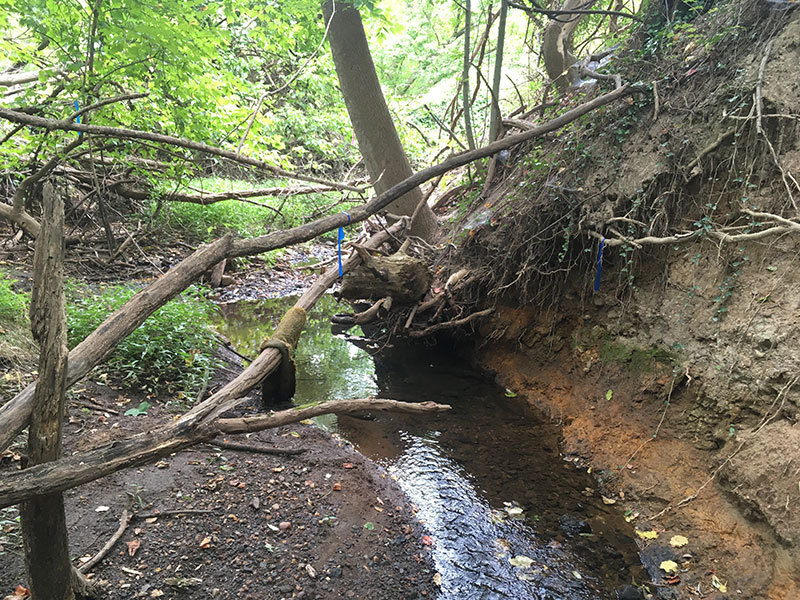
We’re now midway through designing the restoration. When ultimately constructed, the project will not only restore stability to the stream, but also create and enhance wetland and stream habitats and functions. It can also serve as a living lab where students can conduct real-world research on a living system. This includes its ability to retain and slow runoff, treat and sequester nitrogen, phosphorus, and sediments, and reduce the risk of flooding downstream. We look forward to keeping you posted on this project.
Places
Note: At the time of publication, the following events are still scheduled to occur.
May 5-8: Living Futures 2020. The International Living Future Institute announced on March 16 that this conference will now be a digital event. Biohabitats’ Practice Leader, Erin English, will co-lead “The Water Cycle of Buildings,” a four-hour workshop on strategies to achieve the Living Building Challenge Water Petal. Erin and Senior Engineering Technician Ryan Masé will join Andropogon Associates Principal, José Almiñana and Joshua Gassman, Sustainable Design Director at Lord Aeck Sargent, to present “From Scarcity fo Abundance: The Regenerative Power of Net Positive Water. Designers and owners seeking to achieve Net Positive Water in an urban setting will not want to miss that talk.
June 6-11: Quebec RE3 (Reclaim, Restore, Rewild) Conference, Quebec City, Canada. At this joint conference between the Canadian Land Reclamation Association (CLRA), the Society for Ecological Restoration (SER) and the Society of Wetland Scientists (SWS) Joe Berg and Doug Streaker will present a talk on the use of wood structures in ecosystem restoration.
People
Eco-Artists Creates Living Water Map With 8,500 Glass Jars
Earlier this year, environmental artist Stacy Levy, with whom we collaborated on the creation of Philadelphia’s Washington Avenue Green, kicked off an interdisciplinary eco-art adventure with students and faculty from Towson University. Collaborators studies maps, learned about the waterways that comprise their campus watershed, and went out in the field to collect more than 1,000 gallons of water samples from over 40 Chesapeake Bay tributaries. Those samples, which were placed in 8,500 recycled glass jars, now form “Collected Watershed,” a living water map on display in the University’s Center for the Arts Gallery. According to Levy, the project presented an opportunity to tell the story of the Chesapeake Bay in a truly interdisciplinary way. Biology faculty and students helped collect and test water samples; music students captured the sounds of different waterways; art and art history students participated in all stages of the installation. The University’s Office of Sustainability also helped, donating buckets and helping with water collection.
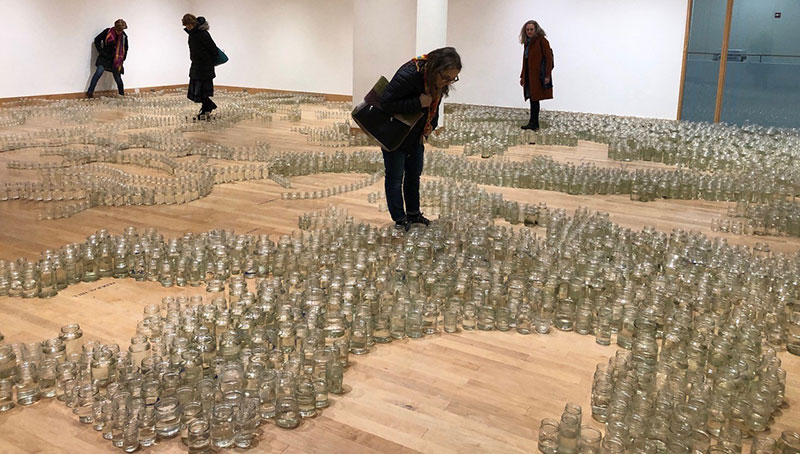
“Our waterways are like capillaries across the land, carrying water from sky to sea,” notes Levy. “The same branching pattern as our blood vessels, the watershed carries the life blood of our planet. Nowadays we know our roads better than our waterways. By not knowing where water flows, we will fail to protect it.”
From Little Acorns Do Mighty Oaks Grow
In his essay, “History,” American Transcendentalist Ralph Waldo Emerson wrote that “The creation of a thousand forests is in one acorn.” This month’s winner of Biohabitats’ Golden Acorn Award illustrates Emerson’s point both figuratively and literally. The quarterly award is presented to a team member who has demonstrated our mission to “Restore the Earth and Inspire Ecological Stewardship.” The gold color symbolizes purity of purpose in protecting and defending nature, and the acorn symbolizes strength of resolve. Our most recent Golden Acorn winner was Executive Assistant, Katherine Bartter who works out of Biohabitats’ Southeast Atlantic Bioregion office in Mt. Pleasant, South Carolina. Katherine was recognized for her unwavering commitment to streamlining our internal communication systems and enabling us to collaborate more efficiently and effectively.

Recipients of the Golden Acorn get to direct a monetary donation to the non-profit organization of their choice, and Katherine chose the South Carolina Native Plant Society. Since the Society works closely with so many organizations and agencies dedicated to protecting ecosystem diversity and health, and since the Society provides robust education, interpretive, and lecture opportunities in addition to their conservation work, Katherine’s donation should have a positive ripple effect in the human and vegetation communities of her region. Katherine also had personal reasons for selecting the South Carolina Native Plant Society. “The Society promotes a mentality of stewardship, care, and investment in your home place,” said Katherine, “a mentality I cherish from growing up in a family of many naturalists, farmers, and gardeners.”
